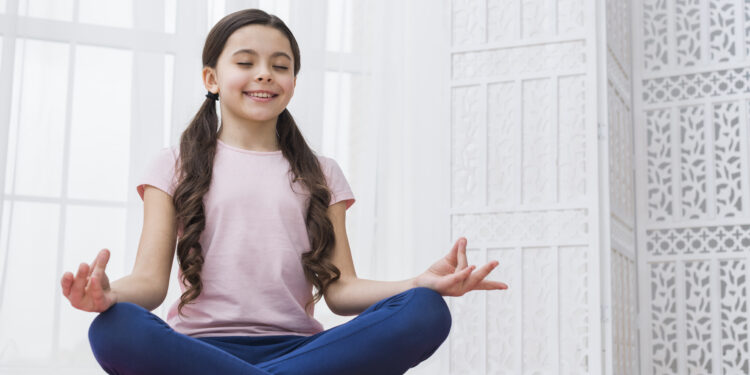Meditation is not just for adults; it can greatly benefit children as well. In fact, introducing meditation to kids at a young age can help them develop self-awareness, self-regulation, and better mental health. It can also improve their attention span and overall well-being. In this comprehensive guide, we will explore the benefits of meditation for kids and provide practical techniques to help them cultivate calm and mindfulness.
Why Should Kids Meditate?
Self-Awareness and Self-Regulation
Meditation is a powerful tool for developing self-awareness and self-regulation in children. By practicing mindfulness, kids can learn to identify their emotions, understand how these emotions manifest in their bodies, and effectively manage their reactions. This heightened awareness allows children to navigate their emotions in a healthy and constructive manner.
Social-Emotional Development
Meditation enhances social-emotional development in kids. It helps them develop empathy, compassion, and understanding towards themselves and others. By practicing mindfulness, children can cultivate a sense of connection and develop better relationships with their peers and family members.
Better Mental Health
Meditation has been shown to have a positive impact on mental health. It can reduce stress, anxiety, and even symptoms of depression in children. By incorporating meditation into their daily routine, kids can build resilience, improve their emotional well-being, and develop coping strategies for dealing with challenging situations.
Increased Attention
In a fast-paced world filled with distractions, cultivating focus and attention is crucial for children. Meditation can improve their ability to concentrate and maintain attention. By practicing mindfulness, kids can train their minds to stay present and focused, which can benefit their academic performance and overall productivity.
Types of Meditation for Kids
1. Five Deep Breaths
Deep breathing is a simple yet effective meditation technique for kids. Encourage your child to take five slow, deep breaths, focusing on the sensation of the breath entering and leaving their body. This practice can help them relax, calm their mind, and release tension. Deep breathing can come in more effortlessly if you ask them to imagine blowing up a balloon with each breath and then letting it go.
2. Mindful Activities
Mindfulness is all about noticing and being present in the moment. Engage your child in mindful activities that encourage observation and awareness. While there are countless activities you can plan with your children based on their interest, here are some which you can explore:
- Mindful Listening: Take time to go outside and sit quietly, focusing on the sounds around you. Encourage kids to identify and describe the different sounds they hear.
- Storytelling with a Twist: Encourage children to create and narrate imaginative stories, incorporating elements of mindfulness, kindness, and gratitude into their narratives.
- Visiting a Pet Store or Zoo: A visit to a pet store or zoo can be an opportunity to observe and discuss the behaviors of animals. Engaging in conversations about their habits, interactions, and unique characteristics encourages mindfulness and can deepen one’s appreciation for the animal kingdom.
- Coloring a Mandala Together: Coloring a mandala with others can be a calming and mindful activity. This shared activity promotes a sense of togetherness and relaxation while encouraging a mindful approach to art and expression.
3. Chanting Om
Chanting “Om” is a powerful and accessible mantra for kids. The Om mantra is believed to represent the sound of the universe and the essence of reality, often described as the sound of creation and associated with the vibration that underpins all existence. Chanting Om is thought to bring a sense of peace, harmony, and connection to the divine, aligning the body, mind, and spirit, leading to a state of deep meditation and spiritual awakening.
Furthermore, it is easy for children to chant “Om” 5-10 times a day and meditate on the sound. This practice helps them develop a sense of inner calm and connection to something greater than themselves.
4. Exploring Nature
Nature itself is incredibly meditative. Encourage your child to have a silent walk in nature, observing their surroundings and connecting with the beauty of the natural world. Afterward, ask them to share their observations and reflections, allowing them to deepen their connection to nature. Here are some activities to explore together:
- Connecting with water bodies: Simply being near water can have a healing and calming effect. The next time you have the opportunity to visit a beach or walk along a river, take a moment with your children to appreciate the beautiful surroundings and listen to the soothing sound of flowing water.
- Discovering hiking trails, trees, and forests: Encourage your kids to explore the wonders of nature by going on hikes through forests or wooded areas. This allows them to connect with the natural world, observe the diverse plant life, and experience the serenity of being surrounded by trees.
- Engaging in outdoor activities: Encouraging children to participate in outdoor activities like camping, birdwatching, or gardening not only provides them with opportunities to connect with nature but also fosters a sense of curiosity and appreciation for the environment.
- Stargazing: Venturing into areas with minimal light pollution to observe the night sky can provide a humbling and awe-inspiring experience, connecting individuals to the broader universe.
5. Listening to Meditative Music or Chanting
Playing meditative music or chants can create a serene atmosphere for your child to relax and unwind. You can play soothing music during their quiet playtime or incorporate it into daily routines like family dinners or breakfast. This gentle background music can help create a peaceful environment for meditation.
6. Short Guided Meditations
Long and intensive meditation practices may not be suitable for young children. Instead, introduce short guided meditations that are tailored to their age and attention span. You can guide them through a body scan meditation or a relaxing visualization, such as walking above the clouds or diving into a white light. Afterward, encourage them to share their experiences and feelings, fostering open communication and reflection.
7. Silence Meditation
Meditation for kids can be flexible and creative. One way to encourage mindfulness is by incorporating short moments of silence into their daily routine. During these silent periods, your child can continue with their activities while remaining silent and not speaking to anyone. This practice allows them to cultivate introspection and mindfulness in their everyday lives. After the silence meditation, encourage them to share their experiences and thoughts, promoting self-reflection and self-expression.
8. Meditate to Set an Example
As a parent or caregiver, you can set an example for your child by practicing meditation yourself. Show them that meditation is valuable and meaningful by incorporating it into your own routine. However, remember that meditation goes beyond scheduled sessions; it is about cultivating conscious thoughts and actions throughout the day. Be present in the moment with your kids, avoid unnecessary stress, and model healthy positive thinking and conscious behavior.
When to Start and How Often to Practice
Meditation can be introduced to children at any age, and the type of meditation should be adjusted based on their readiness and interests. Here are some guidelines for different age groups:
2-5 Years of Age
For younger children, focus on promoting observation skills and emotional expression. Encourage them to observe nature, describe the characteristics of plants and people, and express their feelings through drawing, storytelling, or role-playing. Emphasize imaginative solutions and the exploration of different perspectives, which can lay a foundation for their future meditative experiences.
5-10 Years of Age
In this age group, children can start practicing breathing meditation, gradually increasing the duration from one minute to ten minutes. Deep breathing exercises and body scans can help them relax their bodies and develop a deeper understanding of their physical sensations. These practices also teach them how to send positive healing energies to any areas of discomfort or pain.
FAQs about Meditation for Kids
What is the best age to introduce meditation to kids?
Meditation can be introduced at any age, but it’s essential to consider the child’s readiness and adapt the practice accordingly. Younger children can focus on observation and emotional expression, while older children can engage in more structured meditation techniques. Be flexible and adapt your meditation practice to suit the child’s age and needs.
How Often Should Kids Meditate?
Consistency is key when it comes to meditation for kids. Try to practice meditation with them every day, preferably at a fixed time. This regularity helps them establish a habit and integrate mindfulness into their daily lives.
Are Some Meditation Practices Better Than Others?
There is no one-size-fits-all approach to meditation for kids. The most important factor is that the child enjoys and actively engages in the practice. Choose meditation techniques that resonate with the child’s age and interests. The goal is for them to find joy, peace, and a sense of connection through meditation.
What is the Recommended Time for Kids to Meditate?
Anytime can be the right time for kids to meditate. You can introduce meditation in the middle of the day to help them relax and refocus, or incorporate it into their bedtime routine to promote a peaceful transition to sleep. Again, consistency and predictability are key to creating a sense of comfort and confidence in their meditation practice.
Is Group Meditation Beneficial for Kids?
Group meditation can be beneficial for some kids, as it allows them to experience meditation with friends and learn from each other. However, every child is unique, and some may prefer to meditate alone. Respect their preference and encourage them to practice meditation in a way that feels comfortable for them.
Conclusion
“Teaching kids meditation early is giving them a tool for life that can help them navigate the ups and downs with more ease and grace.” – Gabby Bernstein
Introducing meditation to kids can have a profound impact on their well-being and development. By practicing mindfulness, children can cultivate self-awareness, develop better emotional regulation, and improve their mental health. Through various meditation techniques like deep breathing, mindful activities, chanting, exploring nature, and guided meditations, kids can learn to be present, calm, and focused. As parents and caregivers, we can set an example by incorporating meditation into our own lives and fostering a culture of mindfulness and self-care. So why not embark on this journey of calm and mindfulness with your child today?
















